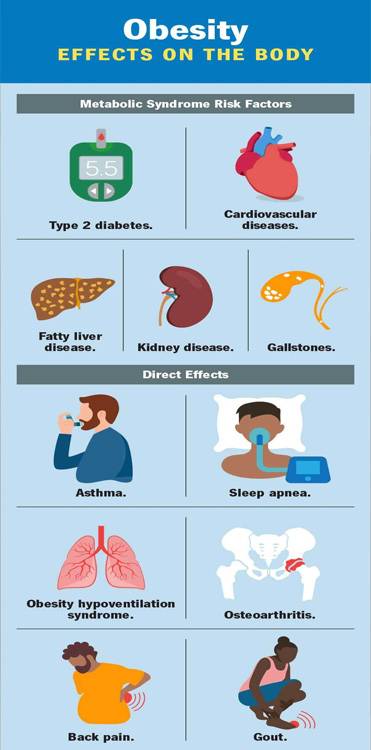Obesity Epidemic: Causes, Impacts, and Solutions
Exploring the Alarming Rise in Obesity, Its Health Impacts, and Effective Solutions for a Healthier Future

Obesity and overweight have become a global health crisis, affecting people across all demographics and regions. In 2022, 1 in 8 people worldwide were living with obesity, marking a significant rise in prevalence over the past few decades. This blog delves into the causes, consequences, and preventive measures for obesity and overweight, highlighting the urgent need for collective action.
Key Facts About Obesity and Overweight
- Prevalence: In 2022, 2.5 billion adults (43% of the global population) were overweight, including 890 million living with obesity.
- Children and Adolescents: Over 390 million children aged 5–19 years were overweight, with 160 million living with obesity.
- Global Trends: The prevalence of obesity among adults has more than doubled since 1990, while adolescent obesity has quadrupled.

- Regional Variations: The prevalence of overweight ranged from 31% in the WHO South-East Asia Region to 67% in the Region of the Americas.
Understanding Overweight and Obesity
Definitions
- Overweight: A Body Mass Index (BMI) ≥25.
- Obesity: A BMI ≥30.
For children, age and gender-specific metrics are used to define overweight and obesity:
- Under 5 years: Weight-for-height greater than 2 or 3 standard deviations above the WHO Child Growth Standards median.
- Aged 5–19 years: BMI-for-age greater than 1 or 2 standard deviations above the WHO Growth Reference median.
Causes
Obesity arises from an imbalance between energy intake and expenditure, exacerbated by:
- Obesogenic Environments: Limited access to healthy food, urban designs that discourage physical activity, and inadequate regulatory frameworks.
- Psychosocial Factors: Stress, mental health issues, and social behaviors.
Genetics: Certain genetic variants and syndromes.
Health Consequences of Obesity
Immediate and Long-Term Risks
- Noncommunicable Diseases (NCDs): Cardiovascular diseases, type 2 diabetes, certain cancers, and respiratory disorders.
Psychosocial Impacts: Stigma, bullying, and reduced quality of life.
Economic Burden: The global costs of obesity are projected to reach $3 trillion annually by 2030 and $18 trillion by 2060.
Double Burden of Malnutrition
Low- and middle-income countries face a dual challenge of undernutrition and obesity, often within the same communities and households. Factors include:
- Inadequate prenatal and early childhood nutrition.
- Increased consumption of energy-dense, nutrient-poor foods.
- Reduced physical activity.
Prevention and Management Strategies
Individual-Level Actions
- Healthy Lifestyle Choices:
Balanced diets rich in fruits, vegetables, legumes, and whole grains, regular physical activity, limiting screen time and sugary beverages. - Early Interventions:
Appropriate weight gain during pregnancy, exclusive breastfeeding for the first six months, promoting healthy behaviors in children.
Health Sector Initiatives
- Regular BMI assessments.
- Counseling on diet and physical activity.
- Integrated obesity prevention and management services.
Policy and Environmental Changes
- Food Industry’s Role:
Reducing sugar, fat, and salt in processed foods, restricting marketing of unhealthy foods to children, ensuring affordable access to nutritious food. - Government Actions:
Implementing fiscal policies to promote healthy diets, urban planning to encourage physical activity, strengthening health systems to address obesity.
WHO’s Response to the Obesity Crisis
The World Health Organization (WHO) has prioritized obesity prevention through:
- Global Nutrition Targets: Aiming to halt the rise in childhood overweight and obesity by 2025.
- Acceleration Plan: Adopted at the 75th World Health Assembly in 2022 to drive sustainable change and strengthen accountability.
- Policy Recommendations: Supporting countries in implementing effective prevention and management strategies.
Frequently Asked Questions (FAQs)
1. What is the difference between overweight and obesity?
Overweight is defined as a BMI ≥25, while obesity is a BMI ≥30. These thresholds vary for children based on age and gender.
2. Why is obesity a global concern?
Obesity increases the risk of chronic diseases, reduces quality of life, and imposes significant economic burdens on healthcare systems worldwide.
3. How can individuals prevent obesity?
Adopting a healthy lifestyle, including a balanced diet, regular physical activity, and adequate sleep, can significantly reduce the risk of obesity.
4. What role does the food industry play in addressing obesity?
The food industry can promote healthy diets by reducing unhealthy ingredients in processed foods, making nutritious options affordable, and restricting marketing of unhealthy foods to children.
5. What is the WHO’s strategy to combat obesity?
The WHO’s strategy includes global nutrition targets, the Acceleration Plan, and policy recommendations to support countries in preventing and managing obesity.
6. What are the economic impacts of obesity?
If unaddressed, obesity could cost the global economy $3 trillion annually by 2030 and $18 trillion by 2060.
7. Why is childhood obesity a critical issue?
Childhood obesity leads to early onset of chronic diseases, psychosocial issues, and increased risk of obesity in adulthood.
8. What is the double burden of malnutrition?
This refers to the coexistence of undernutrition and obesity within the same communities or households, particularly in low- and middle-income countries.
9. How can governments create supportive environments?
Governments can implement policies to promote healthy diets, encourage physical activity, and ensure affordable access to nutritious food.
10. What are the global trends in obesity?
Obesity rates have more than doubled among adults and quadrupled among adolescents since 1990, with significant increases in low- and middle-income countries.
Advertisement
Trending
Popular
Hair loss: Discovery uncovers key stem cells that could reverse ...
-
Broccoli sprout compound may help lower ...
11:31 AM, 25 Feb, 2025 -
Gas Pain vs. Heart Attack: How to tell ...
09:00 PM, 22 Feb, 2025 -
Coconut oil supplement shows promise ...
08:00 PM, 20 Feb, 2025 -
Normal vitamin B12 levels may still ...
05:00 PM, 19 Feb, 2025


